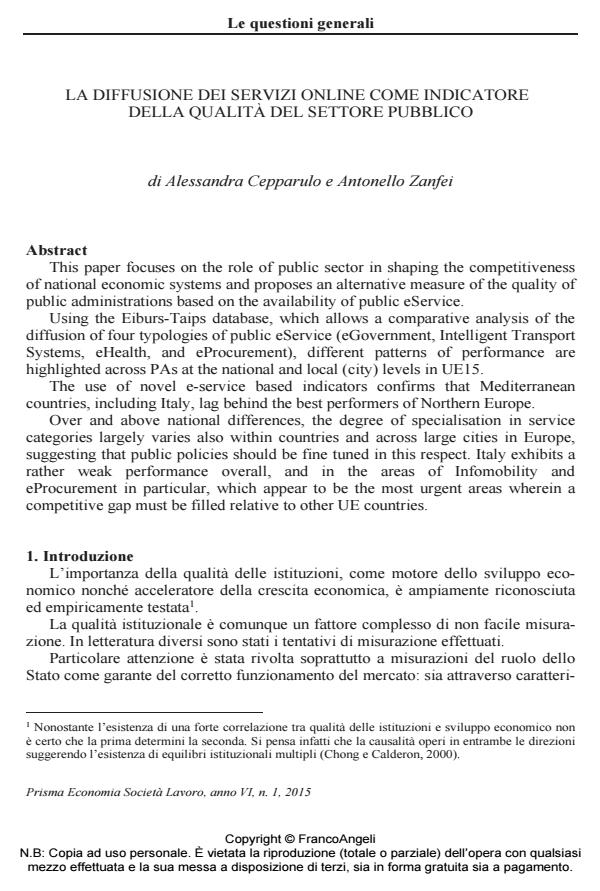La diffusione dei servizi online come indicatore della qualità del settore pubblico
Journal title PRISMA Economia - Società - Lavoro
Author/s Alessandra Cepparulo, Antonello Zanfei
Publishing Year 2015 Issue 2015/1 Language Italian
Pages 19 P. 20-38 File size 248 KB
DOI 10.3280/PRI2015-001003
DOI is like a bar code for intellectual property: to have more infomation
click here
Below, you can see the article first page
If you want to buy this article in PDF format, you can do it, following the instructions to buy download credits

FrancoAngeli is member of Publishers International Linking Association, Inc (PILA), a not-for-profit association which run the CrossRef service enabling links to and from online scholarly content.
This paper focuses on the role of public sector in shaping the competitiveness of national economic systems and proposes an alternative measure of the quality of public administrations based on the availability of public eService. Using the Eiburs-Taips database, which allows a comparative analysis of the diffusion of four typologies of public eService (eGovernment, Intelligent Transport Systems, eHealth, and eProcurement), different patterns of performance are highlighted across PAs at the national and local (city) levels in UE15. The use of novel e-service based indicators confirms that Mediterranean countries, including Italy, lag behind the best performers of Northern Europe. Over and above national differences, the degree of specialisation in service categories largely varies also within countries and across large cities in Europe, suggesting that public policies should be fine tuned in this respect. Italy exhibits a rather weak performance overall, and in the areas of Infomobility and eProcurement in particular, which appear to be the most urgent areas wherein a competitive gap must be filled relative to other UE countries.
- Arduini D., Belotti F., Denni M., Giungato G., Zanfei A., (2010) “Technology adoption and innovation in public services. The case of eGovernment in Italy”, Information Economics and Policy, vol. 22(3), pp. 257-275
- Arduini D., Zanfei A., (2014) “An overview of scholarly research on public eService. A meta-analysis of the literature”, Telecommunications Policy, vol. 38, pp. 476-495
- Arduini D., Cepparulo A., Reggi L., e Zanfei A., (2013) Patterns of e-service development across European cities, paper presentato alla 2nd EIBURS-TAIPS Conference su Innovation in the public sector and the development of eService, Università di Urbino, 18-19 Aprile 2013
- Calista D. J., Melitski J., Holzer M. e Manoharan A., (2010) “Digitized government in worldwide municipalities between 2003 and 2007”, International Journal of Public Administration, vol. 33(12), pp. 588-600.
- EC– Capgemini, (2012) eGovernment benchmark framework 2012-2015, Method paper, Final report, July
- EC-Deloitte, (2011) eHealth Benchmarking III, SMART 2009/0022, Final Report, Bruxelles
- EC- Empirica, (2009) eHealth Benchmarking, Final Report, Bruxelles
- Eusepi G., Cepparulo A. e Verrecchia F., (2011) “La cellula strutturale come ambito di analisi delle performance”, Rivista di Economia e Statistica del Territorio, 2
- IDC, (2008) Benchmarking on-line Public Services, To develop and improve the eGovernment indicators, Final Report, Bruxelles
- IMD, (2014) World Competitiveness Yearbook 2014, Institute of Management Development, ICEG, Budapest
- ITIC-Between, (2010) Infomobilità - Il contributo dell’ICT alla mobilità privata, Secondo Rapporto, Rome
- Osimo D., Szkuta K., Pizzicannella R., Pujol L., Zijstra T., Mergel I., Thomas C., e Wauters P., (2012) Study on Collaborative Production in eGovernment, SMART 2010/0075
- Pina V., Torres L. e Royo S., (2007) “Are ICTs Improving Transparency and Accountability in the UE Regional and Local Governments? An Empirical Study”, Public Administration, vol. 85, pp. 449-472
- Reggi L., Arduini D., Biagetti M. e Zanfei A., (2014) “How advanced are Italian regions in terms of public eService? The construction of a composite indicator to analyze patterns of innovation diffusion in the public sector”, Telecommunications Policy, vol. 38, pp. 514-529
- UN, (2012) EGovernment Survey 2012, EGovernment for the People, United Nations – Department of Social Affairs, New York
- WB, (2013) Doing Business 2014, Comparing Business Regulations for Domestic Firms in 189 Economies, A World Bank Group Corporate Flagship, Washington
- WEF, (2013) The Global Competitiveness Report 2013-2014, Insight Report, The Global Competitiveness and Benchmarking Network, World Economic Forum, Geneva
- Yzerbyt V.Y. e Leyens J. Ph., (1992) “The ingroup overexclusion effect: Impact of valence and confirmation on stereotypical information search”, Journal of Experimental Social Psychology, vol. 22, pp. 549-569
Alessandra Cepparulo, Antonello Zanfei, La diffusione dei servizi online come indicatore della qualità del settore pubblico in "PRISMA Economia - Società - Lavoro" 1/2015, pp 20-38, DOI: 10.3280/PRI2015-001003